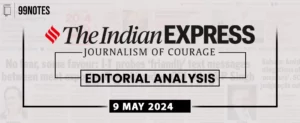Topic: GS2 – Indian polity – Salient features of Representation of People’s Act Critical for UPSC as it evaluates electoral laws, democratic principles, and governance integrity in India. |
| Context: |
| ● The article discusses the legal and democratic implications of unopposed elections in India, highlighting concerns about voter choice and electoral integrity. |
Electoral Laws and Unopposed Elections:
- Rule 11 of the Conduct of Election Rules 1961 allows for the declaration of a candidate as elected unopposed if the number of contesting candidates is equal to or less than the number of seats to be filled.
- Unopposed elections, while legally permissible, raise questions about the democratic process and representation.
Implications of Unopposed Elections:
- Unopposed election victories result in candidates being declared winners without facing any opposition, leading to a lack of choice for voters.
- This phenomenon challenges the essence of democracy, where elected representatives are ideally chosen through a competitive electoral process.
Criticism of Unopposed Elections:
- Critics argue that unopposed elections undermine democratic principles by depriving voters of the opportunity to exercise their right to choose.
- The absence of competing candidates limits the accountability of elected representatives and may lead to complacency in governance.
Role of Electoral Laws and Regulations:
- Section 53 of The Representation of the People Act, 1951 states that if the number of contesting candidates is equal to the number of seats to be filled, all candidates are declared duly elected.
- While this provision is legally valid, it raises concerns about the absence of voter choice and participation.
Challenges with the NOTA Option:
- The introduction of the None of the Above (NOTA) option aimed to empower voters by allowing them to express dissatisfaction with available candidates.
- However, NOTA’s impact on election outcomes is minimal, and it does not effectively address the issue of unopposed elections.
Comparison with Procurement Practices:
- The General Financial Rules (GFRs) provide guidelines for public procurement, emphasising fairness, transparency, and competition.
- While single bids are permissible under certain conditions, lack of competition must not compromise the integrity of the procurement process.
Addressing the Dichotomy in Electoral Processes:
- Unopposed elections highlight a dichotomy between legal compliance and democratic ideals, where candidates can be elected without voter participation.
- There is a need for a broader discussion on electoral reforms to ensure that the democratic process remains robust and inclusive.
Proposed Solutions and Policy Considerations:
- Options for addressing unopposed elections include revising electoral laws to require a minimum percentage of votes for winning candidates or transferring vacant seats to the nominated category.
- These proposals aim to enhance voter participation and strengthen democratic principles in electoral processes.
Conclusion: Ensuring Democratic Integrity:
- Unopposed elections raise significant concerns about democratic representation and voter engagement.
- Addressing this issue requires a comprehensive review of electoral laws and regulations to uphold the integrity and fairness of the electoral process.
- Policy reforms should prioritize empowering voters and promoting competitive elections to sustain democratic values and governance accountability.
| Issues With Unopposed Election |
Issues with Unopposed Elections: ● Democratic Deficiency: Unopposed elections deprive voters of the opportunity to exercise their right to choose their representatives, undermining democratic principles. ● Lack of Accountability: Elected representatives in unopposed elections may lack accountability, as they do not face competition and scrutiny from rival candidates. ● Limited Representation: Unopposed candidates may not adequately represent the diverse interests and opinions of constituents, leading to potential marginalisation of certain groups. ● Diminished Public Engagement: Unopposed elections may result in reduced voter turnout and civic engagement, as voters may perceive their participation as futile. ● Potential for Complacency: Unopposed candidates may become complacent in their roles, as they face no electoral challenge or pressure to perform. Way Forward: ● Electoral Reforms: Introduce reforms to discourage unopposed elections, such as requiring a minimum percentage of votes for winning candidates or promoting greater candidate diversity. ● Strengthening Voter Education: Enhance voter education initiatives to increase awareness about the importance of participation in democratic processes and the consequences of unopposed elections. ● Promoting Political Competition: Encourage the emergence of multiple candidates and political parties to foster healthy competition in elections and ensure robust representation. ● Legal Amendments: Amend electoral laws to address loopholes that enable unopposed elections and ensure greater accountability and transparency in the electoral process. ● Civil Society Engagement: Facilitate civil society involvement in monitoring and advocating for fair and competitive elections, holding elected representatives accountable, and promoting voter participation. ● Public Discourse: Encourage public discourse and debate on the implications of unopposed elections, highlighting the need for democratic reforms and citizen engagement in shaping governance. |
| PYQ: To enhance the quality of democracy in India the Election Commission of India has proposed electoral reforms in 2016. What are the suggested reforms and how far are they significant to make democracy successful? (250 words/15m) (UPSC CSE (M) GS-2 2017) |
| Practice Question: Examine the legal and democratic implications of unopposed elections in India, and suggest reforms to enhance electoral integrity. (150 Words /10 marks) |











